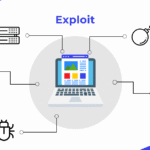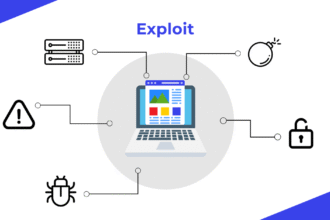In this post, we imagine a chilling but increasingly realistic scenario: how a modern threat actor, borrowing tactics from notorious cybercriminal groups like Scattered Spider, FIN7, or UNC3944, could compromise a mid-sized residential roofing company, particularly one offering in-house financing to its customers.
These aren’t hoodie-wearing loners in basements. Today’s attackers operate more like professional sales teams with playbooks, KPIs, and highly specialized roles, from initial recon specialists to access brokers and data extortion negotiators. And while the headlines focus on casinos and global brands, these methods are trickling down to Main Street businesses, roofing companies, HVAC contractors, law offices, and dental clinics, because the payoff is still rich, and the defenses are often laughably weak.
Our target in this case study? The fictitious Summit Ridge Roofing, A $10M–$20M roofing company with 30–75 employees, a few trucks with logo wraps, an office team of six or so running on cloud-based software like JobNimbus, QuickBooks Online, and some proprietary or third-party tool for managing customer financing plans and lien waivers. It might seem small, but to a threat actor, this is the perfect soft target: just enough data, money, and trust-based workflows to monetize, but not enough cybersecurity maturity to detect or stop a well-orchestrated attack.
We’ll walk through this scenario using the cyber kill chain, a military-rooted cyberwarfare framework covering each phase of an attack from initial recon to final objective, and apply it to this highly specific, highly vulnerable industry. Along the way, we’ll show you how enterprise-grade tactics play out in the SMB world, and what you can do to defend against them before you’re the next cautionary tale.
This isn’t theoretical. It’s already happening. And if your business has files, finances, or customer trust—it’s already in the crosshairs.
First, Reconnaissance: The Quiet Knock on the Door
It started innocently: a new follower on LinkedIn. Then two. Then a connection request from someone claiming to be with a nearby HOA…
Before a single malicious email is sent, the attackers behind the compromise of Summit Ridge Roofing spend several weeks gathering intelligence. This is the recon phase, a slow, deliberate digital casing of the joint. To the attacker, the business is a puzzle, and each open source clue helps complete the picture.
Here’s what they learn, without ever touching a firewall.
Company Website: Built on Wix. They list key services, financing options, project photos, and even client testimonials. A “Meet the Team” page gives away names, roles, and direct emails for several staff members, including the bookkeeper and operations manager.
Social Media: Foremen and project managers post jobsite selfies and tag the company on Facebook and Instagram. One project lead publicly shares before/after videos every week, inadvertently revealing home addresses of recent clients.
LinkedIn: Several employees openly list software tools in their profiles: JobNimbus, QuickBooks Online, and “ProCore Integration.” The office manager reposts an ad for “fast, friendly in-house financing with same-day approval and no interest for one year.”
Google Reviews: Dozens of reviews reference the financing process by name. One customer even describes how they easily can uploaded their credit application directly on the Summit Ridge portal, now the attackers know sensitive PII might be stored internally.
UCC Filings: The attackers search the Secretary of State website and find filings linked to Summit Ridge’s financing entity. These documents name a third-party financial partner, their business address, and the legal structure of the operation.
Job Postings: A listing on Indeed says they’re hiring a “Remote Office Assistant” who will manage ACH deposits, invoice clients, and data entry. The job description identifies the software stack (Google Workspace, Slack, and “custom CRM”). Attackers love job postings because they are often more revealing that the company’s website.
Dark Web Cross-Referencing
The attacker’s next stop? Breach data markets and credential dumps.
- A staff email for the company accountant appears in a 2018 breach of a dental insurance portal. That same password, “Sunshine83!”, is still active on her Summit Ridge email.
- Another login, belonging to a former estimator, is tied to a Dropbox leak and reused on the company’s field photo archive.
- The attacker purchases a batch of verified credentials on a Telegram credential broker channel for $12.
Now, they have:
Internal email addresses
Real passwords
Software platforms in use
Financing partner names
Jobsite client data
Personal info on key staff
No alerts have been triggered. Nothing has been blocked. The attackers haven’t written a single line of malware. And yet, they are nearly halfway through the kill chain.
Second, Weaponization: The Trap is Built
A vendor bid comes in with a familiar subject line. Inside the PDF? A malicious macro that phones home.
With a detailed map of Summit Ridge’s digital landscape, the attackers shift gears. They move from passive observers to active threat actors, crafting customized tools to breach the company’s defenses. This phase, weaponization, is where the raw intelligence turns into tailored attack payloads, designed to exploit specific weaknesses.
Precision Targeting. Unlike spray-and-pray mass phishing campaigns, this attack is highly surgical:
- They’ve identified the finance and operations teams as prime targets, so the malware payloads are disguised as vendor invoices, financing updates, or internal HR announcements.
- Knowing Summit Ridge uses Microsoft 365 and JobNimbus, the attackers build cloned login portals nearly identical to the company’s real cloud portals, right down to logo placement and login button styling.
- A PowerShell payload is wrapped inside a malicious macro-enabled PDF, mimicking an Allied Supply vendor bid the company often receives.
- Multi-Factor Authentication (MFA) fatigue tools are prepared to bomb the finance manager’s phone with repeated push notifications, exploiting human impatience.
The Toolkit. The attackers assemble a ready-to-deploy arsenal:
- Credential Stuffing Bots: Automated scripts that try thousands of username/password combos harvested during reconnaissance on the company’s Microsoft 365 login portals, and especially on the financing portal.
- MFA Fatigue Scripts: Tools that send hundreds of push notification requests per hour to targeted users, hoping one will approve out of frustration.
- Phishing Kits: Customized, brand-faithful email templates, spoofed domains, and fake login pages designed to trick employees into giving up credentials.
- Malicious Attachments: PDFs, Word docs, and Excel files containing obfuscated macros or embedded scripts that download remote access trojans (RATs).
- OAuth Abuse Tactics: In case they gain initial access, they’re ready to create malicious apps or tokens inside Microsoft 365 to maintain persistence even after password resets.
Customization. Attackers customize their payloads to avoid detection:
- The macro in the PDF doesn’t run immediately—it waits for a random delay, hoping to bypass sandboxing and automated antivirus scans.
- The phishing emails mimic Summit Ridge’s tone and recent internal communications harvested from public posts and leaked emails.
- The spoofed login domains use lookalike characters (for example, “summitridg3-finance.com” instead of “summitridgefinance.com”).
- The MFA fatigue attacks are timed for early mornings and late afternoons, when users are busiest and least likely to scrutinize notifications.
Next, Delivery: Phishing That Hits Close to Home
“Hey, can you look over this bid from Allied Supply? Looks like they revised pricing again.”
The email is friendly, timely, and believable. The attachment? Weaponized. The sender? Fake. But the trap works, because it feels familiar.
With their custom payloads and spoofed assets prepared, the attackers execute the delivery phase of the cyber kill chain. Their job is to get a Summit Ridge employee to take the bait, click a link, open a file, or approve an MFA prompt. And thanks to detailed recon and tailored weaponization, their attack slides right through the cracks in Summit Ridge’s everyday workflow.
Spearphishing at its finest. Using public info and previously leaked documents, the attackers craft three parallel phishing lures, each aimed at a specific employee and workflow:
The Office Manager – PDF Phishing
- Email Subject: “Updated Pricing Sheet – Allied Supply [Urgent]”
- Body: “Hi Jill, sorry for the delay. We’ve updated pricing on Owens Corning Timberline HDZs. Let us know if this affects your customer quote for McNally Lane.”
- Attachment: A macro-enabled PDF disguised as a real pricing sheet. The macro, when enabled, silently executes a PowerShell script that installs a lightweight RAT and beacons home.
The Finance Manager – MFA Fatigue + Spoofed Login Page
- The attackers trigger multiple failed login attempts on the company’s Microsoft 365 account.
- The finance manager receives dozens of MFA push notifications on her phone.
- Simultaneously, she gets an email titled “Unusual Login Activity – Please Confirm.”
- The link goes to a perfect clone of the Microsoft login portal, hosted on a domain just one character off from the real one.
- She logs in, thinking it’s Microsoft. The attackers capture her credentials and session token.
The Estimator – JobNimbus Credential Phish
- Email Subject: “JobNimbus System Update – Action Required”
- The email warns of a required login to review updated job queue assignments.
- The link directs the estimator to a spoofed JobNimbus login screen with a fake “Job Routing Update” notification.
- He enters his credentials without noticing the “.co” domain extension.
Other Delivery Vectors Considered. The attackers also explore alternate entry methods:
- Malicious Resume Upload: Submitted through the company’s open job application portal, designed to bypass antivirus scanning and exploit macros in Word.
- Compromised Vendor Email: The attackers briefly compromise the account of a small roofing supplier (previously breached), using it to send legitimate-looking emails with weaponized attachments.
- QR Code Scam: A fake “Discount Material Promo” flyer with a QR code is mailed to the office, designed to be scanned on a personal phone—redirecting to a malware-laced mobile site.
Though not all delivery vectors succeed, they only need one to land.
What Makes This So Effective? The success of delivery hinges on familiarity and timing:
- The language, tone, and branding match what employees are used to seeing.
- The names and references in the emails are real, culled from social media and public reviews.
- The attackers target high-traffic times (Monday mornings and end-of-day rush) when staff are overwhelmed and less vigilant.
- Summit Ridge lacks an email security gateway (SEG), so malicious attachments and spoofed domains aren’t filtered or flagged.
There’s no need to bypass next-gen firewalls or drop zero-days. The users open the door for them. From here, the kill chain moves into exploitation, where attackers capitalize on their newly gained access.
Then, Exploitation: Opening the Vault with the Keys You Were Given
No antivirus alert, no pop-up, no blue or black screen, just business as usual. But in the background? Everything is changing.
By now, the attackers have successfully breached Summit Ridge Roofing’s defenses. They’ve phished credentials, delivered payloads, and established initial access through multiple vectors. The exploitation phase is where those beachheads turn into real leverage, not just reading email, but extracting value, manipulating systems, and preparing for escalation.
In technical terms, this is where malware is triggered, privilege is escalated, and persistence is established. In business terms, this is when you start bleeding money, and don’t even know it yet.
Remote Access Trojan (RAT) on the Office Manager’s Machine
The PDF-based macro executes a PowerShell command that installs a lightweight, encrypted RAT. This gives the attackers full visibility into the office manager’s desktop:
- They screen record and log keystrokes.
- They scrape cached credentials from browsers for vendor portals, CRM, and QuickBooks.
- They observe internal workflows, who signs off on payments, how customer files are stored, and where lien waivers are archived.
Live Session Hijack from Finance Manager’s O365 Account
Thanks to MFA token theft, the attackers bypass authentication and log in as the finance manager directly:
- They read through financial emails, downloading every invoice, ACH instruction, and loan document.
- They set up mail forwarding rules to quietly collect future emails.
- They use her identity to access QuickBooks Online, where they see the company’s full financial picture.
JobNimbus Access Through Estimator’s Credentials
Inside the estimator’s account, they find:
- Project timelines, work orders, and most importantly, customer contact info with attached financing plans.
- File attachments containing scanned IDs, credit applications, and even voided checks from homeowners.
- API keys left in plaintext in the notes field, developer mistakes now turned into a backdoor.
Exploits Unfolding in Real Time. The attackers now begin lateral movement and privilege escalation, combining stolen credentials and system misconfigurations to widen their foothold:
- They run Mimikatz to dump additional credentials from the office manager’s machine, including the shared admin password for the office Wi-Fi router and NAS file server.
- Using those creds, they log into the file server and discover unsecured backups, spreadsheets labeled “FINANCE_2023_MASTER”, and even a folder titled “Legal – DO NOT DELETE”.
- They exploit JobNimbus’s weak OAuth implementation via token reuse to gain access to a project manager’s account without triggering a new login.
Persistence and Preparation for the Next Phase. By chaining these access points together, the attackers escalate privileges and become essentially invisible.
With multiple footholds secured, the attackers ensure they can come back at any time:
- They set up web shell backdoors and redundant RATs on compromised endpoints.
- They create a hidden mail rule in O365 to silently forward specific emails to an attacker-controlled Gmail account.
- They upload a benign-looking Chrome extension to a synced browser session that acts as a credential harvester.
They’re in no rush. This isn’t smash-and-grab, it’s surveillance, planning, and setup for either ransom, fraud, data theft, or all three.
Then, Installation: Digging In for the Long Haul
After exploiting Summit Ridge’s systems, the attackers shift gears, from breaking in to settling in.
They establish persistence by creating hidden accounts, setting email forwarding rules, deploying stealthy remote access tools, and embedding backdoors across devices and cloud services. Even a neglected website form becomes part of their infrastructure.
Their Command & Control (C2) channels hide in plain sight, using encrypted traffic over Google Drive, Slack bots, and even Trello boards to issue commands and extract data unnoticed.
Next, they begin lateral movement, mapping out finance systems, exfiltrating customer PII and loan documents, and syncing file servers to attacker-controlled storage—often using legit tools like Rclone or PowerShell scripts.
By the end of this phase, Summit Ridge is fully compromised but unaware. The attackers have staged invoice fraud, stolen financing records, and are already selling customer data on dark web forums. No ransom yet—just silent monetization.
Next, Command & Control: Running the Show from the Shadows
With footholds established, the attackers now manage their operation remotely, blending seamlessly into normal network traffic.
Their C2 channels are low-and-slow:
- Machines check in through Slack bots, GitHub gists, or encrypted DNS-over-HTTPS.
- Exfiltrated data is quietly uploaded to Dropbox, Google Drive, or a hijacked WordPress site.
- Commands are obfuscated and issued through public tools—hard to detect and even harder to block.
The attackers monitor internal activity in real time:
- They intercept approval emails and calendar invites for loan signings.
- They snoop on VoIP calls tagged as “finance” or “collections.”
- They even watch internal Teams/Slack chatter for signs of suspicion.
If anyone starts poking around, they can shut down, pivot, or retaliate, but their preference is stealth and control.
At this stage, Summit Ridge is being actively managed like a digital asset not just for ransomware, but for long-term exploitation: wire fraud, account takeovers, and a steady drip of valuable PII.
Finally, Actions on Objectives: Cashing Out, Burning Bridges
This is the payday phase.
With Summit Ridge Roofing’s systems fully compromised and under quiet control, the attackers move from reconnaissance and positioning to full-on monetization, executing their endgame with precision. Here’s how they do it.
Financial Exploitation:
- Fake invoices are sent to real customers using legitimate-looking documents, rerouting payments to attacker-controlled accounts.
- They intercept ACH instructions, altering wire details mid-thread in active email chains—classic business email compromise (BEC).
- Vendor payments are duplicated or redirected, bleeding Summit Ridge’s operating cash without immediate detection.
Data Theft & Dark Web Sales:
- Financing docs, Social Security numbers, driver’s licenses, and credit pulls are packaged by ZIP code and credit score.
- The data is sold via Telegram brokers and private dark web forums, marketed as “verified leads” for identity fraud or loan scams.
- Even employee credentials get flipped, sold as access-as-a-service for future attacks.
Final Blow: Extortion and Disruption
Once the well’s been drained, the attackers go loud:
- Ransomware is deployed, locking file servers and QuickBooks data.
- A message demands six figures in Monero, complete with a sample of leaked files as proof.
- If ignored? The attackers threaten a data leak to regulators, media, and competitors, citing customer loan docs as proof of breach.
By the time Summit Ridge realizes what’s happening, it’s already too late. Trust is shattered. Money’s gone. And they’re looking down the barrel of lawsuits, regulatory fines, and reputational collapse.
Epilogue: Summit Ridge Roofing never saw it coming. And that’s the point.
This wasn’t some zero-day exploit or nation-state espionage op, it was an off-the-shelf, playbook-style attack, carried out with discipline and business logic by a crew who’s probably running ten other jobs at the same time. What made Summit Ridge vulnerable wasn’t just weak passwords or a lack of MFA, it was a false sense of insignificance.
“Why would anyone hack a roofing company?”
That question is the biggest vulnerability of all.
Small and mid-sized businesses (SMBs) are under siege. They hold valuable data, process high-dollar payments, and often fly under the radar with aging IT and no full-time security staff. Add in tools like customer financing platforms, lien waivers, and insurance docs, and you’ve got a gold mine for cybercriminals.








